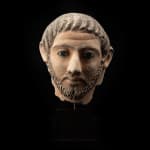Romano-Egyptian Stucco Funerary Mask of a Man, 100 - 300 CE
height 25 cm
height 9 7/8 in
dimensions given without mounting
height 9 7/8 in
dimensions given without mounting
ES.7811
Further images
This remarkably well-preserved Roman-Egyptian funerary mask is a window into the confluence of three different ancient world powers within one stunning archaeological discovery. This funerary mask, likely buried and discovered...
This remarkably well-preserved Roman-Egyptian funerary mask is a window into the confluence of three different ancient world powers within one stunning archaeological discovery. This funerary mask, likely buried and discovered with the man depicted here, dates from the Roman conquest of Egypt, during which a syncretism of Hellenistic, Egyptian, and Roman art styles flourished. This form of funerary art is linked to Egyptian traditions of creating mummy masks, which dates from the Middle Kingdom. Originally, these masks were made of plastered linen or cartonnage – which consisted of plastered layers of fibre or papyrus, which were easily mouldable around the body. The tradition continued throughout the Roman-Egyptian period, although this mask is most likely made of stucco, which was also common in funerary art. The man is fashioned with a Hellenistic hairstyle and glass eyes for added mimesis. The whole visage has been painted in naturalistic colours, which remain vibrant today. Notably, the rim of his eyes have been adorned with Egyptian Blue (or caeruleum in Roman nomenclature) – a synthetic blue pigment consisting of silica, lime, copper, and alkali. It was first manufactured in Egypt during the Fourth Century and remained popular until the end of the Roman period in Europe. The brilliant blue, imitating the lustre of lapis lazuli or turquoise, creates a brightening effect that animates the mask’s features.
Roman-Egypt refers to the period of Egyptian history after its conquest by the Roman Empire in 30 BCE to its loss after Islamic conquest in 641 CE. Roman reign began with the arrival of Octavian, who later took the name Augustus in 30 BC, when his army defeated Marc Antony and Cleopatra’s at the battle of Actium. Upon his rule, Augustus dismantled the Ptolemaic monarchy and dynasty and annexed Egypt as his personal estate. Egypt became a particularly valuable and fruitful region of the Roman Empire, providing an abundance of grain to the city of Rome. Egyptian papyrus, glass, and art were desired and exported throughout the empire. Minerals, ores, and precious stones were also distributed across the empire and incorporated into sculptural and architectural elements. Part of this impact was in Egyptian funerary arts, which evolved to combine Greco-Roman coiffures and dress, as influenced by imperial court fashion in Rome.
Roman-Egypt refers to the period of Egyptian history after its conquest by the Roman Empire in 30 BCE to its loss after Islamic conquest in 641 CE. Roman reign began with the arrival of Octavian, who later took the name Augustus in 30 BC, when his army defeated Marc Antony and Cleopatra’s at the battle of Actium. Upon his rule, Augustus dismantled the Ptolemaic monarchy and dynasty and annexed Egypt as his personal estate. Egypt became a particularly valuable and fruitful region of the Roman Empire, providing an abundance of grain to the city of Rome. Egyptian papyrus, glass, and art were desired and exported throughout the empire. Minerals, ores, and precious stones were also distributed across the empire and incorporated into sculptural and architectural elements. Part of this impact was in Egyptian funerary arts, which evolved to combine Greco-Roman coiffures and dress, as influenced by imperial court fashion in Rome.
22
of
22







